NVIDIA Tegra X1 Preview & Architecture Analysis
by Joshua Ho & Ryan Smith on January 5, 2015 1:00 AM EST- Posted in
- SoCs
- Arm
- Project Denver
- Mobile
- 20nm
- GPUs
- Tablets
- NVIDIA
- Cortex A57
- Tegra X1
Automotive: DRIVE CX and DRIVE PX
While NVIDIA has been a GPU company throughout the entire history of the company, they will be the first to tell you that they know they can’t remain strictly a GPU company forever, and that they must diversify themselves if they are to survive over the long run. The result of this need has been a focus by NVIDIA over the last half-decade or so on offering a wider range of hardware and even software. Tegra SoCs in turn have been a big part of that plan so far, but NVIDIA of recent years has become increasingly discontent as a pure hardware provider, leading to the company branching out in unusual ways and not just focusing on selling hardware, but selling buyers on whole solutions or experiences. GRID, Gameworks, and NVIDIA’s Visual Computing Appliances have all be part of this branching out process.
Meanwhile with unabashed car enthusiast Jen-Hsun Huang at the helm of NVIDIA, it’s slightly less than coincidental that the company has also been branching out in to automotive technology as well. Though still an early field for NVIDIA, the company’s Tegra sales for automotive purposes have otherwise been a bright spot in the larger struggles Tegra has faced. And now amidst the backdrop of CES 2015 the company is taking their next step into automotive technology by expanding beyond just selling Tegras to automobile manufacturers, and into selling manufacturers complete automotive solutions. To this end, NVIDIA is announcing two new automotive platforms, NVIDIA DRIVE CX and DRIVE PX.
DRIVE CX is NVIDIA’s in-car computing platform, which is designed to power in-car entertainment, navigation, and instrument clusters. While it may seem a bit odd to use a mobile SoC for such an application, Tesla Motors has shown that this is more than viable.
With NVIDIA’s DRIVE CX, automotive OEMs have a Tegra X1 in a board that provides support for Bluetooth, modems, audio systems, cameras, and other interfaces needed to integrate such an SoC into a car. This makes it possible to drive up to 16.6MP of display resolution, which would be around two 4K displays or eight 1080p displays. However, each DRIVE CX module can only drive three displays. In press photos, it appears that this platform also has a fan which is likely necessary to enable Tegra X1 to run continuously at maximum performance without throttling.
NVIDIA showed off some examples of where DRIVE CX would improve over existing car computing systems in the form of advanced 3D rendering for navigation to better convey information, and 3D instrument clusters which are said to better match cars with premium design. Although the latter is a bit gimmicky, it does seem like DRIVE CX has a strong selling point in the form of providing an in-car computing platform with a large amount of compute while driving down the time and cost spent developing such a platform.
While DRIVE CX seems to be a logical application of a mobile SoC, DRIVE PX puts mobile SoCs in car autopilot applications. To do this, the DRIVE PX platform uses two Tegra X1 SoCs to support up to twelve cameras with aggregate bandwidth of 1300 megapixels per second. This means that it’s possible to have all twelve cameras capturing 1080p video at around 60 FPS or 720p video at 120 FPS. NVIDIA has also made most of the software stack needed for autopilot applications already, so there would be comparatively much less time and cost needed to implement features such as surround vision, auto-valet parking, and advanced driver assistance.
In the case of surround vision, DRIVE PX is said to deliver a better experience by improving stitching of video to reduce visual artifacts and compensate for varying lighting conditions.
The valet parking feature seems to build upon this surround vision system, as it uses cameras to build a 3D representation of the parking lot along with feature detection to drive through a garage looking for a valid parking spot (no handicap logo, parking lines present, etc) and then autonomously parks the car once a valid spot is found.
NVIDIA has also developed an auto-valet simulator system with five GTX 980 GPUs to make it possible for OEMs to rapidly develop self-parking algorithms.
The final feature of DRIVE PX, advanced driver assistance, is possibly the most computationally intensive out of all three of the previously discussed features. In order to deliver a truly useful driver assistance system, NVIDIA has leveraged neural network technologies which allow for object recognition with extremely high accuracy.
While we won’t dive into deep detail on how such neural networks work, in essence a neural network is composed of perceptrons, which are analogous to neurons. These perceptrons receive various inputs, then given certain stimulus levels for each input the perceptron returns a Boolean (true or false). By combining perceptrons to form a network, it becomes possible to teach a neural network to recognize objects in a useful manner. It’s also important to note that such neural networks are easily parallelized, which means that GPU performance can dramatically improve performance of such neural networks. For example, DRIVE PX would be able to detect if a traffic light is red, whether there is an ambulance with sirens on or off, whether a pedestrian is distracted or aware of traffic, and the content of various road signs. Such neural networks would also be able to detect such objects even if they are occluded by other objects, or if there are differing light conditions or viewpoints.
While honing such a system would take millions of test images to reach high accuracy levels, NVIDIA is leveraging Tesla in the cloud for training neural networks that are then loaded into DRIVE PX instead of local training. In addition, failed identifications are logged and uploaded to the cloud in order to further improve the neural network. Both of these updates can be done either over the air or at service time, which should mean that driver assistance will improve with time. It isn’t a far leap to see how such technology could also be leveraged in self-driving cars as well.
Overall, NVIDIA seems to be planning for the DRIVE platforms to be ready next quarter, and production systems to be ready for 2016. This should mean that it's possible for vehicles launching in 2016 to have some sort of DRIVE system present, although it's possible that it would take until 2017 to see this happen.



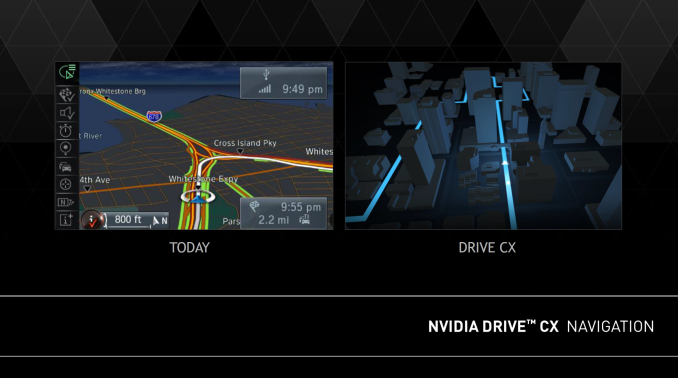
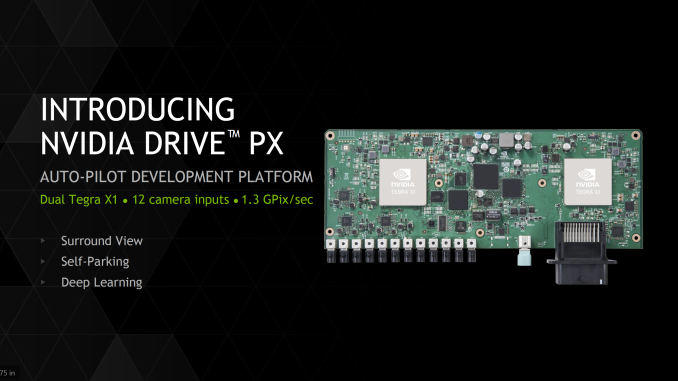
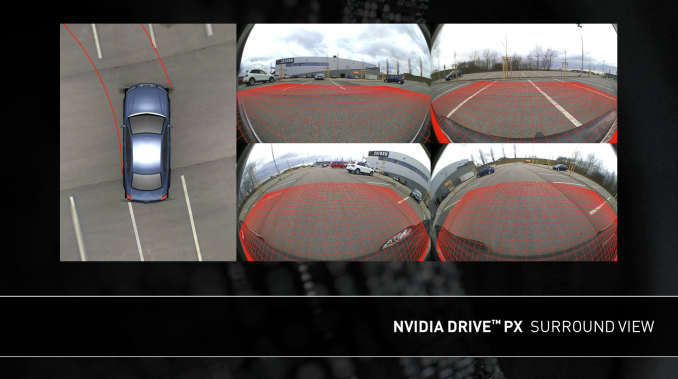

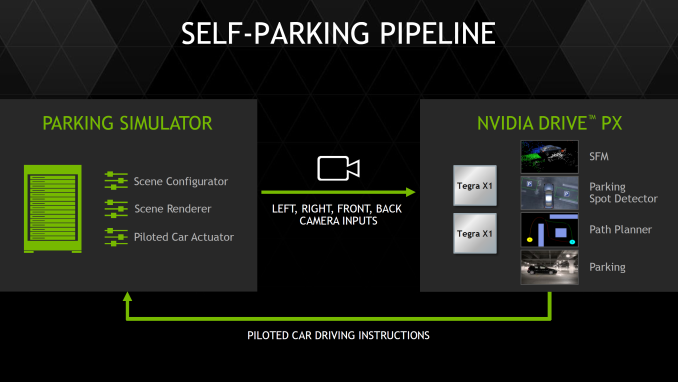


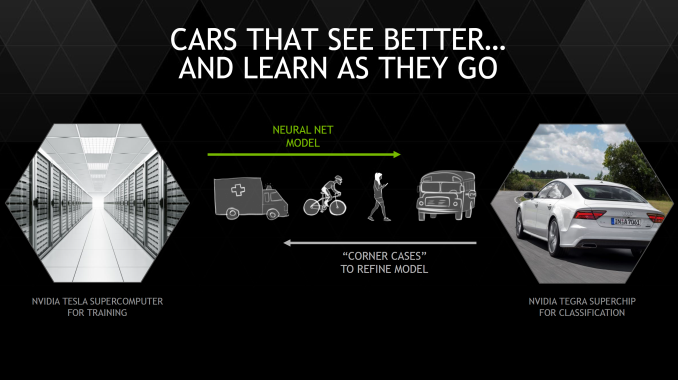
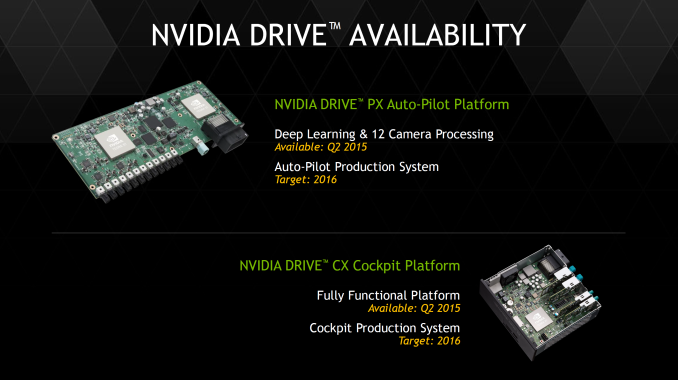








194 Comments
View All Comments
esterhasz - Monday, January 5, 2015 - link
Only one of the three devices you mention runs on Denver cores (Nexus 9) and performance reviews have been very uneven for that device, to say the least.PC Perv - Monday, January 5, 2015 - link
Oh I don't know, man. All I know is that every Galaxy tablet has either Exynos or Snapdragon in it.OK, maybe not all of them but I do not think Tegra is in any of them.
kron123456789 - Monday, January 5, 2015 - link
Yeah but it's either Exynos 5420 or Snapdragon 800/801.darkich - Monday, January 5, 2015 - link
Well you dont know much then.Tegra K1 got to market along with the Snapdragon 805 and Exynos 5433.
Out of those three, the K1 took most design wins .
Dont compare the K1 with other Snapdragon and Exynos chips ,and the sea of MTK, Rockchip, Allwinner and Intel atoms chips.
It is an entirely different market
darkich - Monday, January 5, 2015 - link
Clarification- by "most design wins" I was referring to tablet market of courselucam - Wednesday, January 7, 2015 - link
Let's say 2 since one is Nvidia reference tablet and of course it always wins.chizow - Monday, January 5, 2015 - link
@jcwalla, I'm not sure there's "no fruit" from their investment, they are now on their 6th major iteration of Tegra (1-4, K1, X1) with a major variant in Denver K1 and while their marketshare and Tegra revenue won't reflect it, they are clearly the market leader in terms of performance for Android SoCs while going toe-to-toe with the monstrous Apple. Not bad, considering I am positive Apple is probably investing more than Nvidia's yearly revenue in keeping their SoC's relevant. ;)Breaking into an established market and growing a business from scratch is hard, but Nvidia clearly sees this as an important battle that needs to be fought. As a shareholder and tech enthusiast, I agree, in 10 years there's no doubt I would want an Nvidia GPU in whatever handheld/thin device I am using to power my devices.
The problem is that Nvidia lacks the "killer app" that really distinguishes their SoC over others. Even Apple is beginning to understand this as there's nothing on iOS that remotely takes advantage of the A8X's overkill specs. Nvidia needs to grow the Android/mobile gaming market before they really distinguish themselves, and from what I have seen, THAT is their biggest problem right now.
jwcalla - Monday, January 5, 2015 - link
Tegra is an important LOB for NVIDIA, but I'm more talking about how Denver has been received. When it was in the rumor stage, the scuttlebutt seemed to be about how they were going to marry ARMv8 CPU cores with discrete cards and take over the HPC world, etc. Then that got filtered down to "Yeah Denver is just a custom ARMv8 core for Tegra." (Which isn't earth-shattering; Qualcomm and Apple had been doing custom designs for a long time.) And now it doesn't seem like Denver is really anything special at all.But did it not involve a lot of hype, money, and time over all those years?
chizow - Monday, January 5, 2015 - link
Well, I think that HPC embedded ARM core in a massive GPGPU is still a possibility, but again, you're looking a very focused usage scenario, one which I think was pushed back by the process node delays at 20nm and now 16nm FinFET. We have seen since then Nvidia's roadmaps have changed accordingly with some of the features migrating vertically to new generation codenames.But the important point is that Nvidia's investment in mobile makes these options and avenues possible, even if Tegra isn't lightning up the P&L statements every quarter.
Yojimbo - Monday, January 5, 2015 - link
NVIDIA seems to be marrying themselves to IBM in the HPC space, but maybe ARM HPC is a different segment than what PowerPC occupies? I don't know. But IBM has a lot of experience and expertise in the area. Maybe NVIDIA thought they were biting off more than they could chew, maybe the Denver CPU just wasn't performing well enough, or maybe the opportunity with IBM came along because IBM realized they could benefit from NVIDIA as they didn't have anything to compete with Intel's Xeon Phi, and NVIDIA jumped at it.